|
February
2004
|
|
|
Next | ||
| Home Wildlife Dragonflies 2003 Butterflies 2004 Moths 2003 **** most recent update |
|||
|
Kingfisher
- Lake Lothing - February 2004 - © Robert Wilton
|
|
This website is best navigated using: http://home.clara.net/ammodytes/ |
RED-THROATED
DIVER Gavia stellata
****
Kessingland - 1st (7 N, 23 S, 2 on sea), 2nd (3 S,
3 o/s), 3rd (8 N, 4 S, 2 o/s), 4th (36 N, 4 S, 1 o/s), 5th (5 N, 15
S, 1 o/s), 6th (1 N, 2 S), 7th (2 S, 2 o/s), 8th (1 N, 1 S, 1 o/s),
9th (40 N, 1 S, 1 o/s), 10th (8 N, 6 S, 1 o/s), 11th (1 o/s), 12th (3
N 6 S), 13th (5 N, 1 S, 3 o/s), 14th (15 N), 15th (30 N, 9 S, 9 o/s),
16th (2 N, 12 S), 17th (16 N, 7 S, 1 o/s), 18th (16 N, 17 S), 19th (6
N, 8 S), 20th (10 N, 5 S), 21st (5 N, 1 S, 2 o/s), 22nd (9 N), 23rd
(55 N, 5 S, 4 o/s), 24th (29 N, 3 S), 25th (44 N, 3 S, 6 o/s), 26th
(37 N, 8 S, 2 o/s), 27th (22 N, 3 S).
Ness Point - 29th (36 N).
BLACK-THROATED DIVER Gavia arctica
One flew north past Kessingland on the 25th.
LITTLE GREBE Tachybaptus ruficollis
Lake Lothing - 1st (6), 22nd (3).
Leathes Ham - 1st (4), 8th (5).
GREAT CRESTED GREBE Podiceps cristatus
****
Kessingland - 4th (1 S), 12th (3 S, 73 o/s), 13th
(2 N, 26 S, 40 o/s), 15th (2 N, 18 S, 16 o/s), 16th (2 N, 20 S, 51 o/s),
17th (4 S, 12 o/s), 18th (6 N, 3 S, 10 o/s), 19th (4 N), ) 21st (4 N),
23rd (17 N, 1 S), 24th (2 N, 4 S), 25th (3 N, 1 S), 26th (1 S).
Ness Point - 3rd, on on the sea, 29th (2 S).
Leathes Ham - 8th (1).
Oulton Broad - 29th (2).
FULMAR Fulmarus glacialis ****
Ness Point - 1st (1 N), 29th (90+ N, 1 dark morph
['Blue' Fulmar] south on the sea).
Kessingland - 16th (1 N), 17th (1 S), 19th (10 N, 1 S), 20th
(15 N), 21st (2 N).
On the 29th several large gulls were noted mobbing a drab grey bird
huddled on the water close inshore at Ness Point. It was tail on to
the observers at first, but when it turned it proved to be a dark morph
Fulmar! It looked decidedly odd with the head and breast concolourous
with the mantle and wings. We dashed along the sea wall to try and get
photos of it, but the tide was carrying it southwards faster than we
thought, and we had to run the whole 600 metre stretch to Hamilton Dock.
Not an easy task in a pair of Wellingtons; and with the bird constantly
disappearing in the swell, and mostly staying tail on to shore, only
the poorest record shots were obtained. However the dark grey head is
clearly visible in the photo below.
It didn't seem to respond to the mobbing by the gulls and probably wasn't
in the best of health. The same day five dark morph birds and several
'normal' individuals were picked up dead on Blakeney Point in North
Norfolk.
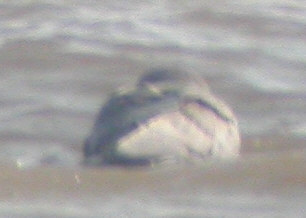 |
|
Dark
morph Fulmar ('Blue' Fulmar) - Ness Point - 29th February 2004
- © Andrew Easton
|
One
other definite dark morph bird was seen flying north at Ness Point on
the 29th. One or two others may have been seen earlier in the day as
well, but the lighting conditions at the time were not brilliant and
made it difficult to be certain.
GANNET
Morus bassanus
****
Kessingland - 3rd (1 N), 4th (1 N), 6th (2 N), 9th (1 N),
13th (1 N), 15th (5 N), 18th (6 N), 19th (111 N), 20th (72 N), 21st
(8 N), 22nd (25 N), 23rd (4 N), 24th (43 N), 25th (1 N), 26th (4 N),
27th (25 N).
Ness Point - 22nd (2 N), 29th (106+ N).
CORMORANT Phalacrocorax carbo
****
Kessingland - 1st (1 S), 2nd (1 S), 4th (4 N), 8th (2
S), 9th (5 N, 2 S), 10th (1 N, 1 S), 11th (1 N, 2 S), 13th (1 N), 14th
(1 S), 16th (1 S), 18th (1 N), 22nd (1 N, 1 S), 24th (1 S), 26th (5
S).
Ness Point - 12th (1 S), 22nd (1 N), 24th (1 S), 29th
(1 N).
EUROPEAN
SHAG Phalacrocorax aristotelis
Thirteen were roosting on the Kittiwake Wall in Lowestoft Harbour
on the evening on the 1st, with ten there on the 2nd. However on the
evening of the 14th the wall was devoid of life, rather surprising,
as a few usually linger into May!
On the 15th three were at the western end of Lake Lothing, but again
none were roosting on the Kittiwake Wall in the evening. Perhaps they
took exception to being battered about by the westerly gales in recent
weeks and have found a new roosting site now? At least one was along
Lake Lothing on the 22nd.
MUTE SWAN Cygnus olor
Leathes Ham - 8th (2).
Oulton Broad - 8th (5).
BEWICK'S SWAN Cygnus (columbianus) bewickii
At approximately 8:30 on the 18th, 35 Bewick's Swans flew north
over the River Hundred then headed north east out over the sea. Later
in the morning a flock of c.80 were seen flying south-eastwards over
Ellough, quite possibly the same flock of around 80 seen early morning
over the University of East Anglia and then the centre of Norwich itself!
PINK-FOOTED GOOSE Anser brachyrhynchus
A flock of 20 flew north past Ness Point on the 8th; and a flock
of 60 flew north over Corton Sewage Works on the 14th.
CANADA GOOSE Branta canadensis ****
Two were at Leathes Ham on the 8th and 15th. Two flew north
over Corton Sewage Works on the 14th, and shortly after they returned
and settled to feed in fields to the south. Three were at Lound Waterworks
on the 22nd and 29th. One flew north past Kessingland on the 24th. A
surprisingly scarce species in this area.
BRENT GOOSE Branta bernicla bernicla
Kessingland - 2nd (1 N, 1 S), 3rd (2 S), 4th (3 S), 9th (7
S), 18th (3 N).
SHELDUCK Tadorna tadorna
Kessingland - 5th (1 S), 9th (1 S), 12th (1 N, 5 S), 14th
(1 N), 16th (6 N, 8 S), 21st (2 N).
WIGEON Anas penelope
Leathes Ham - 1st (6), 8th (6), 15th (6).
Kessingland - 4th (7 S), 15th (40 o/s), 16th (4 o/s).
Ness Point - 15th (35 S).
MALLARD Anas platyrhynchos
Two flew north past Kessingland on the 11th.
GADWALL Anas strepera
****
Leathes Ham - 1st (22), 8th (6+), 15th (15+),
22nd (13), 28th (8).
Lound Waterworks - 22nd (15), 29th (28).
TEAL Anas crecca
Kessingland - 4th (1 S), 7th (1 S).
Ness Point - 22nd (30 N).
PINTAIL Anas acuta
Kessingland - 4th (17 S), 6th (40 N), 24th (3 S).
Oulton Broad - 16th (26 flew east).
SHOVELER Anas clypeata
Leathes Ham - 1st (7+), 8th (30+), 15th (20+).
Kessingland - 10th (1 S), 12th (2 S).
RED-CRESTED POCHARD Netta rufina
****
The drake at Leathes Ham first seen on December 14th was still
present on the 22nd at least, but there was no sign of it on the 28th.
There were no Wigeon and very few Gadwall present on the 28th either
and it may well have now moved on.
Viewing can be difficult, and the bird is best looked for from either
the railway bridge at the western end of the Ham or from the main car
park at Normanston Park. It tends to keep to the far side opposite the
car park with the Wigeon and Gadwall. With a bit of luck it will linger
for the coming months, it'll certainly add a bit of sparkle to the cold
days that lie ahead!!!
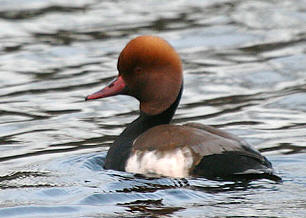 |
|
Red-crested
Pochard - Leathes Ham - December 26, 2003 - ©Tim Brown
|
POCHARD
Aythya ferina
Leathes Ham - 1st (3), 28th (1).
TUFTED DUCK Aythya fuligula ****
Leathes Ham - 1st (10), 8th (10), 15th (10+),
28th (20).
Oulton Broad - 15th (3), 22nd (3).
Lound Waterworks - 22nd (10), 29th (15).
SCAUP Aythya marila
The female was still on Oulton Broad on the 27th, but back along
the northern shore near the old Maltings buildings.
COMMON EIDER Somateria mollissima
Kessingland - 18th (3 N), 20th (1 N).
COMMON SCOTER Melanitta nigra
Kessingland - 9th (17 N), 14th (2 N), 15th (18 N), 19th
(5 N), 20th (7 N), 22nd (1 N), 23rd (4 N), 25th (2 N), 26th (2 N).
GOLDENEYE Bucephala clangula
Kessingland - 9th (1 N), 16th (1 N, 2 S).
RED-BREASTED MERGANSER Mergus serrator
Three flew north past Kessingland on the 20th.
RED KITE Milvus milvus
One flew south over Mutford on the morning of the 7th. Possibly
the same bird was photographed at Sotterley the next day, although two
different birds have been wandering East Suffolk between here and Minsmere
at least.
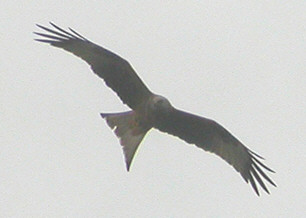 |
|
Red
Kite - Sotterley - 8th February 2004 © Dick Walden
|
RED-LEGGED
PARTRIDGE Alectoris rufa
Two were at Corton on the 8th.
GREY PARTRIDGE Perdix perdix
Two were in the MoD field at Corton on the 8th and three were at
Corton Sewage Works on the 14th.
WATER RAIL Rallus aquaticus
****
On the 1st at least two were calling beside the River Waveney at
Fritton, and three were heard at Kessingland on the 15th. One was seen
at Camps Heath, Oulton on the 29th.
OYSTERCATCHER Haematopus ostralegus
Kessingland - 13th (3 N), 16th (6 N), 17th (2 S), 26th (1
N).
Ness Point - 7th (1 N), 29th (1 S).
RINGED PLOVER Charadrius hiaticula
Kessingland Beach - 10th (2), 12th (2), 14th (4),
15th (2), 17th (5), 19th (1), 25th (1 o/b), 26th (6 o/b).
Hamilton Dock - 28th (1).
GOLDEN PLOVER Pluvialis apricaria
Two flew in off the sea at Kessingland on the 2nd.
LAPWING Vanellus vanellus
Four flew north past Ness Point on the 17th.
SANDERLING Calidris alba
Kessingland - 2nd (1 on beach), 6th (3 o/b), 13th (1 o/b),
25th (1 S).
Lowestoft South Beach - 7th (6).
Hamilton Dock - 8th (1), 22nd (1), 28th (2).
Ness Point - 24th (1).
PURPLE SANDPIPER Calidris maritima
Ness Point - 1st (1), 5th (4), 7th (7), 15th (5), 17th
(8), 18th (6), 24th (4), 26th (5), 28th (3), 29th (6).
DUNLIN Calidris alpina
Kessingland - 5th (42 S).
COMMON SNIPE Gallinago gallinago ****
One flew west over Corton Sewage Works on the 14th. Three were at
Oulton Marshes on the 29th.
WOODCOCK Scolopax rusticola
Kessingland - One flew south close inshore on the 13th, and
one was near the Sewage Works on the 28th.
Corton Sewage Works - Two were feeding together on the
21st, with a single bird there on the 28th.
CURLEW Numenius arquata
Two flew north past Kessingland on the 19th.
REDSHANK Tringa totanus
Lake Lothing - 1st (7).
COMMON SANDPIPER Actitis hypoleucos
One was along Lake Lothing on the 3rd and 27th. Possibly the same
individual seen back in December.
TURNSTONE Arenaria interpres
****
Ness Point - 1st (1), 5th (6), 12th (4), 15th (11), 24th
(1), 29th (18).
South Pier - 14th (40+ roosting).
Hamilton Dock - 28th (5).
Kessingland - 3rd (1 S), 6th (3 on beach),
7th (7 o/b), 10th (1 o/b), 12th (4 o/b), 13th (1 o/b), 15th (2 o/b),
17th (1 o/b), 18th (1 o/b), 19th (1 o/b), 20th (3 o/b), 21st (4 o/b),
22nd (1 o/b), 24th (8 o/b), 26th (11 o/b), 27th (15), 29th (15, all
of which were trapped and ringed). That's what happens when you try
to nick the food put down to attract the Snow Buntings!
MEDITERRANEAN GULL Larus melanocephalus
****
Kessingland - 10th (1 adult south), 14th (1 adult north),
23rd (1 adult south).
Pakefield - 13th (1 adult).
Gorleston - 21st (1 1st winter, 3 adult), 22nd (1 adult).
Leathes Ham - 28th (1 adult bathing).
Breydon South Wall - 29th (1, 2nd winter in fields).
KITTIWAKE Rissa tridactyla
Kessingland - 1st (16 N, 35 S, 30 feeding), 2nd (good numbers
feeding north and south with gulls about 3 kilometres from the beach),
3rd (again good numbers feeding with gulls. Approximate rate 100 south
low to the sea in 2.5 minutes, then returning north), 4th (14 N, 7 S),
5th (3 N, 12 S), 6th (1 S), 7th (10 S), 8th (35 N, 3 S), 9th (88 N),
10th (1 S, 1 feeding), 12th (67 N, 4 S), 18th (11 N, 4 S), 19th (8 N,
1 S), 20th (70 N, 1 S), 21st(2N) 22nd (7 N, 6 S), 23rd (32 N, 3S), 24th
(42 N, 27 S), 25th (43 N, 3 S), 26th (5 N, 5 S), 26th (35 N).
One perched on groynes
at Pakefield on the 13th may be an indication that breeding birds are
starting to return, rather than just passing offshore.
GUILLEMOT Uria aalge
Ness Point - 8th (3 N).
AUK sp. Alcidae
****
Kessingland - 1st (16 N, 6 S), 3rd (5 N), 4th (6 N, 3
S), 7th (3 N, 1 S), 8th (2 N, 1 S), 9th (10 N), 10th (9 N, 1 S), 12th
(1 N), 15th (1 N), 18th (1 N), 19th (8 N), 20th (4 N), 21st (23 N),
22nd (2 N), 23rd (10 N), 24th (12 N, 1 S), 25th (3 N), 26th (2 N, 2
S), 27th (9 N, 1 S).
Ness Point - 29th (24 N).
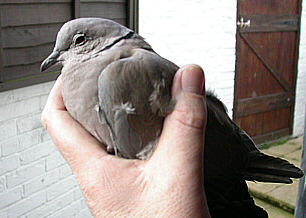 |
|
"Sooty"
Collared Dove - Lowestoft - February 2004 © Robert Wincup
|
COLLARED
DOVE Streptopelia decaocto
The dove pictured above became an undeniable house tick when it
appeared in the living room of a house in St. Margaret's Road, Lowestoft
on the 18th, having fallen down the chimney. Birding at its' best, from
the comfort of your own armchair in true Lounge Lizard style........
BARN OWL Tyto alba ****
One was hunting in the fields around Corton Church at dusk on the
28th. One was seen at Browston Golf Course near Lound on the 29th, with
two at Camps Heath, Oulton the same day.
KINGFISHER Alcedo atthis
Lake Lothing - 1st (1), 15th (1), 22nd (2).
Lound Waterworks - 14th (1).
GREEN WOODPECKER Picus viridis ****
One was sharing a tree with a drumming Great Spotted Woodpecker
at Bond's Meadow, Oulton Broad on the 21st.
ROCK PIPIT Anthus petrosus
Two went to roost on the South Pier on the evening of the 2nd, and
one was at Ness Point on the 29th.
GREY WAGTAIL Motacilla cinerea
Oulton Broad - 1st (1).
Kessingland Sewage Works - 7th (1), 15th (2), 22nd (2),
28th (2).
Corton Sewage Works - 14th (1 flew west high overhead).
St. Margaret's Road, Lowestoft - 15th (1 south).
Lowestoft Town Centre - 21st (1 overhead).
PIED WAGTAIL Motacilla alba
Fifteen were roosting in the bare trees outside Dorothy Perkins in Lowestoft
Town Centre on the evening of the 2nd, with 13 there on the 4th and
6th, 17 on the 12th, 15 on the 17th, only one on the 20th, but back
to 17 on the 25th and 27th.
Seven were along the North Beach sea wall on the 12th. At least forty
were at Kessingland Sewage Works on the 15th, along with four White
Wagtails M.a alba.
BOHEMIAN WAXWING Bombycilla garrulus
Three were again at St. Pauls Close, Beccles on the 5th and 17th.
Six were seen at the Rookery Park Golf Club, Carlton Colville on the
17th.
FIELDFARE Turdus pilaris ****
70 were in fields along Jay Lane, Lound on the 29th.
BLACKCAP Sylvia atricapilla
A male was again in a garden in Kessingland on the 20th; one having
been seen there on January 4th.
CHIFFCHAFF Phylloscopus collybita
The Siberian Chiffchaff type bird was still present on the
7th, along with at least two other Chiffchaffs including the individual
with the stunted bill.
Three individuals were trapped and ringed at Kessingland on the 15th
and at least two other (singing birds) were present. The trapped birds
included a typical nominate type bird (pictured below left), long staying
one with the deformed bill, and the equally long staying Siberian
Chiffchaff type individual (pictured below right). It was not recognised
as such in the hand as although very pale it had an olive tone throughout
the whole of the upperparts, and the distinct supercilium was a very
pale creamy yellow. It was presumed to be an abietinus individual.
When seen in the field later these tones were not apparent and it again
looked brown, buff and white. In the photographs taken of it in the
hand it also lacked these tones and appeared very brown and white, particularly
around the head, the only green apparent is again in the wing and tail
feather edgings. Wherever it comes from we hope to see it again next
winter.
At least two were still present on the 22nd. Two were again seen on
the 28th, both being ringed individuals, including the Siberian Chiffchaff
type bird which was heard to call twice for the first time. A loud ringing
'peep' without any inflection, though lacking the mournful quality
often associated with this form, but strikingly different from the 'hweet'
calls of nominate and abietinus birds. So on call as well as
plumage it would appear to be from the eastern end of the Chiffchaff
range, though whether it is a full tristis or an integrade remains
unclear.
One was in gardens in Stevens Street, Lowestoft on the 29th.
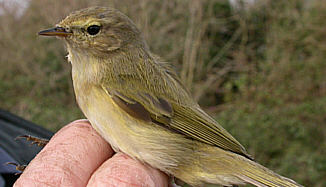 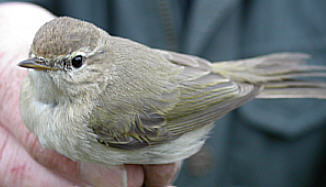 |
|
Chiffchaffs
- Kessingland - 15th February © Andrew Easton
|
FIRECREST
Regulus ignicapilla
One was still at Kessingland Sewage Works on the 22nd. Two were
present there on the 28th, and one of them was trapped and ringed.
BEARDED TIT Panurus biarmicus
Several were calling at dusk beside the River Waveney at Fritton on
the 1st.
JAY Garrulus glandarius
One was ringed at Corton on the 14th, along with two others seen.
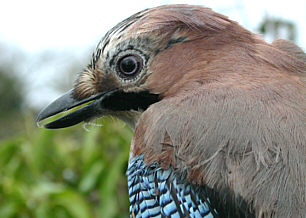 |
|
Jay
- Corton - 15th February © Andrew Easton
|
CHAFFINCH
Fringilla coelebs
At least 20 were with the Yellowhammers at Corton on the 14th, with
at least 50 on the 22nd, and over 30 on the 29th still.
GREENFINCH Carduelis chloris
At least 20 were at Corton on the 21st, with the odd Goldfinch mixed
in.
GOLDFINCH Carduelis carduelis
Six were at Corton on the 14th, and two were at Kessingland on the
28th..
SISKIN Carduelis spinus
A flock of 30 flew north over Corton Sewage Works on the 14th and
then headed for the coast, whether to head out to sea or along the coast
we couldn't tell. Six were at Kessingland Sewage Works on the
15th.
LINNET Carduelis cannabina
At least three were at Corton on the 14th, with 34 there on the
21st.
TWITE Carduelis flavirostris ****
One was along the south wall of Breydon Water on the 6th and 29th.
BULLFINCH Pyrrhula pyrrhula
One female was at Corton Sewage Works on the 14th, and three birds
were at Kessingland on the 15th. Two were at Fisher Row on the 29th.
HAWFINCH Coccothruastes coccothraustes
One flew over Mutford on the 15th.
SNOW BUNTING Plectrophenax nivalis
****
Kessingland - 1st (103), 2nd (100+), 3rd (100+), 5th (100+),
6th (100+), 7th (80+), 8th (100+), 9th (70+), 10th (50), 11th (50),
12th (40), 14th (45), 15th (45), 16th (45), 17th (70+), 18th (30), 19th
(50), 20th (50), 21st (30), 22nd (35), 23rd (35), 24th (17), 25th (21),
26th (21), 27th (17), 29th (28).
Twenty out of the twenty eight trapped on the 29th were new birds, bringing
the total ringed there this winter to a very respectable 124.
YELLOWHAMMER Emberiza citrinella
****
A flock of 25 was at Corton on the 8th, with at least 30 there
on the 14th. This had increased to at least 51 on the 28th and 29th.
At least six were at Gunton Beach on the 29th, including two singing
males.